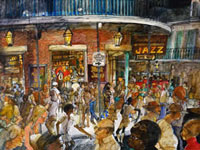|
Take a French Quarter
Architecture Walking Tour online right now!
 |
| Royal Street |
 |
| Jazz Clubs on Bourbon |
 |
| French Quarter in the Rain |
No visit to New Orleans is complete until you
visit the French Quarter. This wonderful area has it all: exquisite architecture, history,
elegant shops, lacy ironwork, jazz clubs, and, of course, Bourbon Street.
There is really nothing else quite like it in this country, and you must
walk the cobblestone streets to savor it all.
The first thing to remember about the French
Quarter is that this area is authentic, not a reproduction of history. Many of the
buildings found here date back to the 1700's, and most of the architecture
is Spanish, not French. The entire area consists of 120 blocks, nestled
on the bend of the Mississippi River.
The second thing to remember is that the French
Quarter is a thriving neighborhood, with residents and businesses that
have inhabited the area for generations. There are private homes, condominiums,
apartments, as well as small grocery stores, restaurants, museums, banks,
a police station and other services.
In New Orleans, there are more than 35,000
buildings listed on the National Register of Historic Places, more than
any other U.S. city. Many of these treasures of architecture are located
in the French Quarter.
This area is steeped in history and holds some
of the most architecturally significant buildings in the U.S. Here you
will find:
-
The Cabildo (1795-99), the site of
the signing of the Louisiana Purchase in 1803. 701 Chartres St.
-
The Cathedral of St. Louis, King
of France, the oldest continuously active Roman Catholic Cathedral
in the U.S. (re-dedicated in 1794, following the fire of 1724), Chartres
St. facing Jackson Square.
-
Jackson Square/ Place d'armes, used
as a drill field for the French militia in 1721, now a public park.
-
The Old Ursuline Convent (1745) is
the oldest building in the Mississippi River Valley. 1100 Chartres
St.
-
The Pontalba Buildings (1849-51)
considered by many historians to be the first apartments in America,
flanking Jackson Square.
-
Le Petit Theatre du Vieux Carre (1789-95),
the oldest continuously running community theatre in the United States.
502 St. Peter St.
-
Avart-Peretti House (1842), a brick
town house where Tennessee Williams lived while writing "A Streetcar
Named Desire." 632 St. Peter St. Later Williams bought an 1830's Greek
Revival town house at 1014 Dumaine St.
-
Faulkner House Books (1840), a town
house where William Faulkner lived and wrote his first novel, "Soldier's
Pay" and "Mosquitoes." It is now a charming bookstore. 624 Pirate's
Alley.
-
Truman Capote's apartment (1831),
native son Truman Capote lived here in 1945 and wrote his first book,
"Other Voices, Other Rooms." 711 Royal St.
-
Beauregard-Keyes House (1826), home
of former Confederate General Pierre Gustave Toutant Beauregard (1866-68)
and later noted author Frances Parkinson Keyes. 1113 Chartres St.
-
Gallier House Museum (1857), a Creole-style
town house furnished to the period with more than 6000 artifacts.
1132 Royal St.
-
Madame John's Legacy (1788), one
of the oldest homes in the Quarter and the only home with a wooden-columned
gallery. 623 Dumaine St.
-
Hermann-Grima House Museum (1832),
a fusion of Creole and American floor plans and the only Federal-style
mansion in the French Quarter. 820 St. Louis St.
-
The Historic New Orleans Collection,
a complex of five buildings at Royal and Toulouse Streets, including
the Jean Francois Merieult House (1792) one of the few buildings to
survive the fire of 1794. 527-33 Royal St. and 718, 726-28 Toulouse
St.
-
Royal Street, with ten blocks of
some of the most elegant antique stores and homes in the country,
many of which have been owned, operated and lived in by the same families
for generations.
-
Chartres Street, with blocks of elegant-to-funky
antique stores, the visitor can find designer shoes at discount prices,
chic accessories for the home, antique French culinary ware to suit any taste
and more.
- Bourbon Street, with blocks of jazz
and Dixieland clubs, restaurants, souvenir shops and adult entertainment,
this street attracts visitors from all over the world.
There are many more historic buildings
in the French Quarter. We invite you to come to New Orleans and walk through
the streets of the Quarter and make discoveries of your own.
|
